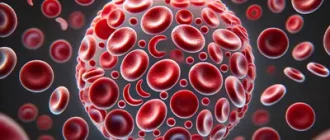Sickle cell disease (SCD) is a group of inherited red blood cell disorders that can cause a range of symptoms affecting multiple systems in the body. Early identification of these signs is crucial for timely intervention and improved quality of life.
Common Symptoms Reported by SCD Patients
| Symptom | Percentage of Patients |
|---|---|
| Anemia | 85% |
| Pain Crises | 70% |
| Frequent Infections | 50% |
| Swelling (Dactylitis) | 40% |
| Vision Problems | 25% |
What is Sickle Cell Disease?
SCD occurs when a person inherits two copies of the sickle cell gene (one from each parent). This condition causes red blood cells, which are typically round and flexible, to assume a rigid, sickle-like shape. These cells can block blood flow and lead to severe complications. But how does this translate into symptoms?
Common Symptoms of Sickle Cell Disease
1. Anemia
Anemia is one of the hallmark symptoms of SCD. The sickle-shaped cells break down prematurely, leading to a shortage of red blood cells. This condition is called hemolytic anemia. Symptoms of anemia include:
- Fatigue and weakness
- Pale or yellowish skin (jaundice)
- Shortness of breath, especially after physical activity
2. Pain Crises
Periodic episodes of pain, known as sickle cell crises, are among the most common and debilitating symptoms. Pain occurs when sickle-shaped cells block blood flow to specific areas. These crises can:
- Last from a few hours to several days
- Occur in the chest, abdomen, bones, or joints
- Vary in intensity, from mild discomfort to severe pain requiring hospitalization
3. Swelling in Hands and Feet (Dactylitis)
Painful swelling in the hands and feet is often an early sign of SCD in infants and young children. This occurs when sickle cells block blood flow in small bones and tissues.
4. Frequent Infections
SCD damages the spleen, an organ essential for fighting infections. As a result, individuals with SCD are more susceptible to:
- Bacterial infections such as pneumonia, meningitis, or osteomyelitis can occur more frequently in individuals with SCD due to immune system vulnerabilities.
- Viral illnesses like influenza, parvovirus B19, or hepatitis are also of concern, as they can exacerbate anemia and lead to other complications.
Timely vaccinations and antibiotics are critical to prevent severe infections.
5. Delayed Growth and Puberty
Children with SCD often experience delayed growth and puberty. The lack of healthy red blood cells impacts the oxygen supply needed for growth and development.
6. Vision Problems
Blockages in tiny blood vessels supplying the eyes can lead to vision complications such as:
- Retinopathy
- Blurred vision
- Permanent vision loss in severe cases
Did You Know?
Individuals with SCD often have an increased risk of stroke due to blockages in blood vessels leading to the brain. According to the CDC, 10% of children with SCD experience a stroke by the age of 20.
Severe Complications of Sickle Cell Disease
While the symptoms above are more common, severe complications can develop without proper management. These include:
Acute Chest Syndrome
This life-threatening condition resembles pneumonia and is caused by blockages in the lungs. Symptoms include:
- Chest pain
- Fever
- Difficulty breathing
Organ Damage
Chronic damage to organs such as the liver, kidneys, and heart can occur due to prolonged oxygen deprivation.
Leg Ulcers
Poor circulation may result in painful, slow-healing sores on the legs.
How is SCD Diagnosed?
Sickle cell disease is typically diagnosed through several reliable methods designed to identify the condition as early as possible:
- Newborn screening: Early testing is essential to begin treatment promptly. This screening, often performed shortly after birth, identifies the presence of hemoglobin S or other abnormal hemoglobins.
- Blood tests: These confirm the presence of hemoglobin S, the defective form of hemoglobin associated with SCD. Blood tests can also assess red blood cell counts and look for signs of anemia or other abnormalities.
- Family medical history analysis: Understanding the genetic history of a family can help identify potential carriers of the sickle cell gene and assess the likelihood of SCD in offspring.
What Can Be Done to Manage Symptoms?
Management of SCD often focuses on reducing the frequency and severity of symptoms while improving the overall quality of life. This includes a multi-faceted approach combining medical treatments, proactive health monitoring, and supportive lifestyle adjustments:
- Medications: Hydroxyurea can decrease the frequency of pain crises and reduce the need for blood transfusions. Additionally, newer treatments like L-glutamine or voxelotor have shown promise in reducing complications associated with SCD by targeting different mechanisms of the disease.
- Regular check-ups: Monitoring organ function and overall health is vital. Regular blood tests, imaging studies, and screenings for potential complications like kidney or liver damage can help address issues before they become severe. Specialists may also assess heart function and eye health regularly.
- Lifestyle changes: Staying hydrated is crucial to prevent blood cells from becoming too sticky, which can exacerbate blockages. Avoiding extreme temperatures, such as prolonged exposure to cold or intense heat, is essential as these can trigger crises. Managing stress through techniques such as deep-breathing exercises or structured routines can also be beneficial. Incorporating a nutrient-rich diet and moderate physical activity helps to strengthen the body and improve resilience against complications.
- Educational support and counseling: Patients and their families benefit from understanding the nature of SCD and how to manage its challenges. Accessing support groups or counseling can alleviate the psychological burden associated with chronic illness, creating a better support network for affected individuals.
Effectiveness of Treatment Options for SCD
| Treatment Option | Reduction in Pain Crises |
|---|---|
| Hydroxyurea | 70% |
| L-Glutamine | 60% |
| Voxelotor | 50% |
| Blood Transfusions | 40% |
| Stem Cell Transplant | 90% |
Editorial Advice
Understanding the signs and symptoms of sickle cell disease is a step toward timely diagnosis and effective management. If you or a loved one are experiencing symptoms suggestive of SCD, consult a healthcare provider for evaluation and guidance. Early intervention can make a significant difference in outcomes and quality of life.
About the Author
Reyus Mammadli is the author of this health blog since 2008. With a background in medical and biotechnical devices, he has over 15 years of experience working with medical literature and expert guidelines from WHO, CDC, Mayo Clinic, and others. His goal is to present clear, accurate health information for everyday readers — not as a substitute for medical advice.







